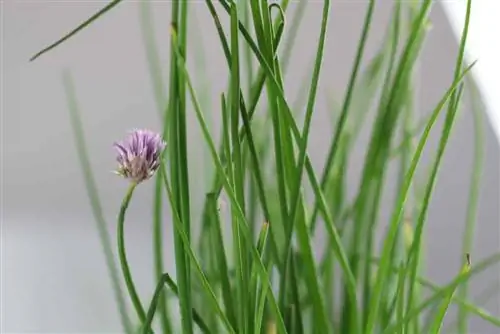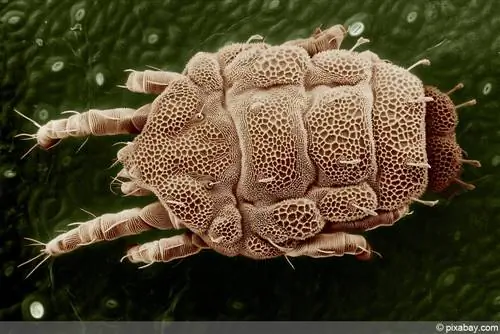- Author admin [email protected].
- Public 2023-12-17 03:39.
- Last modified 2025-01-24 12:45.
Flea bites that can be recognized as such should be treated accordingly, otherwise a wound infection can easily occur. They can also transmit various pathogens such as bacteria that can cause so-called typhus or tapeworm larvae. These animals can survive indoors in their cocoons for up to a year. Rodents and birds are also often affected by fleas and can, for example, enter the apartment through a bird's nest near a window.
Identifying flea bites correctly
As already mentioned, flea bites are not a sign of poor hygiene, although the so-called human flea has been almost eradicated in Central Europe due to the now high hygiene standards. That's why flea bites today mostly come from other species, but especially from dog and cat fleas. Once in the home, these parasites nest in clothing, carpets, upholstery or mattresses and multiply rapidly there. Even though fleas cause a lot of discomfort in the home, their bites are certainly the most unpleasant thing about the whole thing. They are not immediately recognizable as flea bites because these skin irritations sometimes resemble allergic skin reactions to other substances. In contrast, they are easy to distinguish from insect bites. While stings from bees, wasps or mosquitoes cause extensive swelling and ants or spiders only leave two small marks, flea bites always have similar bite structures.
A flea bite itself is not painful. It is only 12-24 hours later that wheals form, a reaction of the body to the saliva of the fleas. These wheals are usually arranged in groups or rows. There is redness and swelling at the puncture sites, which causes very intense itching.
Tip:
The arrangement of the bites comes from the fact that the flea makes real test drillings on the human body until it finally finds a blood vessel to tap into.
Initial treatment for obvious bites
If flea bites are clearly identified as such, appropriate countermeasures can be taken. In most cases, flea bites are cured without any problems in this country, in contrast to tropical countries where serious diseases such as plague, swine fever or even polio can be transmitted. First of all, it makes sense to shower thoroughly, including your hair. You can combat the itching by applying cold, damp cloths or cold packs to the itchy areas. These can relieve both itching and swelling. Slightly cooling, pain-relieving and itching-relieving ointments and gels from the pharmacy that are also used against other insect bites or eczema are said to be helpful.
If extreme itching occurs, the doctor may also prescribe a homeopathic remedy to take orally. If the punctures or bites have become infected or if additional symptoms arise such as headaches, fever, nausea or even shortness of breath, you should definitely see a doctor. This also applies if flea bites do not heal or become infected. Normally the itching should disappear after a few days and the swelling or hives should also disappear a few days later.
Tip:
What you should definitely not do is itch, because that poses the greatest danger, but this is very difficult given the unbearable itching. However, scratching can cause bacteria to get into the wounds, causing the whole thing to become inflamed and complications can then arise.
What to do next
If flea bites have been identified, it is important to also treat pets living in the household accordingly. Commercially available flea collars or flea drops are suitable for this, as they can be used to destroy fleas but also as a preventive measure. You can also have your vet prescribe an anti-flea medication that kills both the fleas and their larvae and eggs. Since fleas can nest anywhere in the home, it is important to wash all clothing that could be infested at at least 60 °C. The same applies to blankets, curtains, cuddly toys and the like. Textiles that cannot tolerate such high temperatures should, if possible, be placed in the freezer or freezer for at least 12 hours. Smooth floors are best cleaned with a steam cleaner and carpets are vacuumed thoroughly and immediately disposed of in the household waste. This cleaning procedure must be repeated for several consecutive days, and very meticulously. Pets' sleeping places also need to be cleaned thoroughly. If necessary, it may make sense to dispose of them completely.
If you swear by home remedies, you can, in addition to the measures mentioned, try to eliminate fleas by placing a soup plate with water and a drop of dishwashing liquid on the floor. The purpose of the dishwashing liquid is to break the surface tension of the water so that the fleas cannot escape again. A candle or a small raised block is placed in the middle of the plate and a tea light on top. The heat emitted by candles or tealights attracts fleas. With a bit of luck, they jump towards the candle and fall into the water, where they ultimately drown. However, the room in question must be darkened.
Tip:
The treatment of the people concerned, the pets and the apartment should, if possible, always be carried out at the same time in order to prevent the fleas from spreading again.
Effectively prevent the parasite
- Flea bites are best prevented by protecting household pets from infestation.
- Flea collars or a flea comb can be helpful.
- Otherwise, you should clean your pets' sleeping areas and their cuddle areas regularly.
- This also includes all textiles and upholstery that you often sit on.
- Frequently air and beat out the bedding of human residents and carpets.
- Wipe floors made of laminate, parquet, tiles or similar regularly.
- Vacup carpets at regular intervals and always empty them immediately.
Conclusion of the editors
Fleas are parasites that are normally not dangerous, but their bites can be very unpleasant. In order to best protect yourself from them, you should protect your pet accordingly, especially if it spends a lot of time outside or has contact with other animals. With regular grooming, for example with a so-called flea comb, a possible infestation can be detected early and, if necessary, nipped in the bud. Otherwise, cool diligently and always consult a doctor in the event of complications.
What you need to know about flea bites in brief
In most cases, flea bites are not a sign of uncleanliness. They are often caused by fleas that are brought into the home by pets such as dogs and cats, so children are particularly often affected because they often have very close contact with the animals and also like to take them into their rooms and beds. This type of fleas are cat and dog fleas, which generally prefer the blood of these animals, but are also satisfied with the blood of humans if necessary.
Detecting flea bites on people
- Flea bites are round and often in a row because the fleas bite multiple times.
- The parasites are easily irritated by human movements or other disturbances.
- The skin around the bite is red and extreme itching occurs, which can spread widely.
- Because most fleas are nocturnal, most people are bitten while they sleep.
- You then scratch yourself unconsciously, which makes the itching even worse.
- Scratching can easily cause inflammation.
- The scratched areas also make it easier for bacteria transmitted by fleas to penetrate.
Flea bite treatment
- As a first measure to reduce itching, we recommend cooling the affected areas with water or ice.
- Alternatively, you can use a cooling gel from the pharmacy, some of which also relieve the itching.
- As a result, the entire apartment and especially the bed should be freed from fleas so that there are no further bites.
Fleas look for warm and soft places where they rest during the day and attack people and animals at night. They are usually found in beds, cat and dog beds, upholstered furniture, carpets and other fabrics. These potential locations can be cleared of fleas in the following ways.
- Thoroughly vacuum carpets and upholstered furniture
- Machine wash clothes and other fabrics as hot as possible
- Sprinkle flea powder, let it take effect according to the manufacturer's instructions and then vacuum it up
- Wash children's cuddly toys, vacuum them thoroughly or put them in the freezer for a day
Since most fleas are brought into the home by pets such as cats and dogs, the animals should also be examined and treated. If the animals spend a lot of time outdoors, they should be given a flea collar, which is available at a pet store or veterinarian. So-called spot-ons are dripped or sprayed into the neck of the animal and from there they kill all fleas in the fur.






